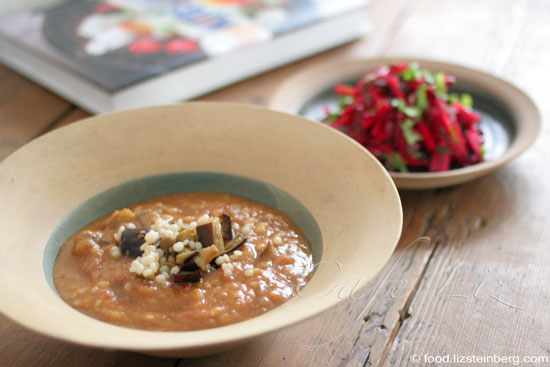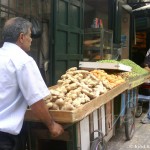Jerusalem, where food and cultures collide — a cookbook review

Could a book entitled “Jerusalem” really not be political — even if that book is a cookbook? That was the main question in my mind as I waited to receive a review copy of Yotam Ottolenghi and Sami Tamimi’s latest book, named after the city where both chefs were born and raised — Ottolenghi on the western Jewish side, Tamimi on the eastern Arab side.
The chefs, partners in London and the writers of the bestseller Plenty, are known for their Mediterranean style of cooking, heavy on vegetables and spices — a style clearly inspired by their childhood in this region. In their latest book, “Jerusalem: A cookbook,” they present a mix of dishes popular in Jerusalem — childhood favorites, recipes passed on by friends, and their own chef creations. The book does not aspire to be the definitive document on food in this region; rather, it is best seen as a collection of foods that two Jerusalem natives feel passionately about. I found myself nodding in agreement over many of the hotspots and anecdotes they chose to feature.
While the foods and the stories are presented as being about Jerusalem, much of what is said also holds true for Israel as a whole. The recipes are overwhelmingly vegetarian friendly, and many are kosher friendly too. To judge by the photos and by the recipes I tried, the dishes are colorful, vibrant and full of strong flavors. While many of the ingredients may be considered exotic in the English-speaking countries where the book’s target audience presumably lives, I had no problem finding any of them, with one exception (chervil). All these recipes, of course, are the chefs’ interpretation of dishes from traditional ethnic fare to modern creations — but more on that later.
Indeed, it was no surprise that the book broaches the issue of politics early on. It started with an explanation — “A comment about ownership” — that foods can belong to many different people, and that many similar variations of dishes can be found in different cultures. Can’t argue with that. And then it stated that this book sought to avoid politics altogether. I have to say that I was disappointed — I’d been hoping to see something a little more controversial.
But indeed, politics seep in nonetheless. Interspersed with the recipes, the book offers vignettes about life in Jerusalem, ingredients, dishes and their stories, and the communities that make them. Therein lies a great part of this book’s value — the documentary aspect. But once you start discussing history, you inevitably touch on ownership. Some stories left me wanting to add a rebuttal. Take for instance the explanation of the small pasta known as Israeli couscous, accompanying the recipe “Burnt eggplant and mograbieh soup” (p141, shown in the top photo on this post, alongside “Root vegetable slaw with labneh,” p49). The book notes that the Arabic name, mograbieh, reflects the dish’s source of inspiration — Maghreb means north Africa, a reference to couscous — and that some people feel that calling a similar pasta-type dish Israeli couscous is an Israeli attempt to obfuscate this dish’s origins. But in Hebrew everyone calls the dish ptitim — nibs — and no one would recognize the term Israeli couscous. Where does the name Israeli couscous came from? Are you blaming Israelis for a name slapped on by a food exporter or something? I wanted to add.
Any attempt to tell in-depth stories about something so closely tied to identity is bound to run into issues of this kind. I could guess that other stories would leave other people of all sorts of ethnic backgrounds feeling the same way. And I’m sure plenty of people will have something to say about the declaration that Jerusalem is “the world capital of kibbeh” (p159), even if the book presents plenty of arguments to back that statement up. Though personally, I like that it dares to make such a risque and controversial claim.
Another pitfall is the conciseness of some of the stories, which left me feeling like some cultural sensitivities had been left on the editing room floor. Take for instance a story accompanying the recipe “Pureed beets with yogurt and zaatar” (p53) about Michal Baranes and Yakub Barhum, a mixed Jewish-Arab couple who run a restaurant that serves shrimp balls that resemble falafel. It’s difficult to understate just how utterly taboo everything about this is — a point that Ottolenghi well conveys in his documentary Jerusalem on a Plate. Presumably, that’s what makes the story notable in the first place. But all that is missing from the paragraph devoted to them in the book, which is too bad, since ultimately this is a book about more than recipes.
Also, kosher cooks will also note that several meat recipes described as traditional Jewish happen to call for yogurt as a condiment. Clearly these recipes are the chefs’ interpretation of classic dishes — but I believe they should have stated in the headnotes that the originals would not have mixed meat and dairy.
Ultimately though, if you can get past the above, you’ll find a collection of vibrant stories and equally vibrant recipes. I tried a dozen or so of the dishes from the sections on vegetables, soups and grains/pulses, and we enjoyed them all, particularly the “Burnt eggplant and mograbieh soup” — an innovative recipe nothing short of brilliant for its unconventional use of flame-grilled eggplant — and the “Mixed bean salad” (p42), which features a fragrant mix of tarragon, cumin seeds and capers. The photos are inspiring, particularly given that nearly all the ingredients are easily sourced locally, and I found myself flipping through it for ideas after trips to the shook.
Altogether, I found this an enjoyable if culturally challenging read that awakens dreams of Jerusalem, even if it’s only a short busride away.




